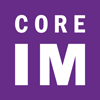Core IM
During Covid the incidence of alcohol-associated liver disease has increased. While much has been taught to learners about use of steroids, we find little focus on other modalities of treatment including alcohol cessation and malnutrition. There is significant concomitant malnutrition in patients diagnosed with alcohol-associated hepatitis and alcohol cessation has significant improvement in mortality. Join the Core IM crew as they explore diagnosis, risk factors, treatments, and more in 5 Pearls: Alcohol Associated Hepatitis.
First, listen to the podcast. After listening, ACP members can take the CME/MOC quiz for free.
CME/MOC:
Up to 0.75
AMA PRA Category 1 Credits ™ and MOC Points
Expires November 11, 2025
active
Cost:
Free to Members
Format:
Podcasts and Audio Content
Product:
Core IM
Welcome to Core IM, a virtual medical community! Core IM strives to empower its colleagues of all levels and backgrounds with clinically applicable information as well as inspire curiosity and critical thinking. Core IM promotes its mission through podcasts and other multimodal dialogues. ACP has teamed up with Core IM to offer continuing medical education, available exclusively to ACP members by completing the CME/MOC quiz.

Pearl 1: How to diagnose
How do you diagnose alcoholic hepatitis? Why is this important?
- There has been a significant uptick in alcohol use and alcohol associated liver disease during the pandemic.
- Diagnosis is usually made by clinical history and laboratory values:
- Typically with long history of drinking (e.g. 10+ years), with usually increase
- Symptoms often vague but may present with anorexia, malaise. Patients usually jaundiced. Patients with cirrhosis can present with decompensated cirrhosis (e.g. hepatic encephalopathy, variceal hemorrhage)
- Onset of jaundice within 60 days of heavy alcohol consumption for a mininum of 6 months
- Moderately elevated AST, ALT. Typically less than 300 U/L
- AST/ALT ratio > 1.5-2/1
- Serum Bilirubin >3 mg/dL
- Patients with history of gastric bypass are at higher risk for developing alcohol associated hepatitis.
- Other risk factors
- Biologic females
- Smoking history
- Genetic component
- Metabolic syndrome
Pearl 2: Differential Diagnosis and Workup
2. What other things should you consider in your differential diagnosis?
- When diagnosing, should exclude other causes:
- Anti-hepatitis A IgM
- Hepatitis B surface antigen, anti-hepatitis B core IgM
- Anti-hepatitis C virus (HCV) antibodies
- Drug screen including serum acetaminophen levels
- Biliary obstruction or Budd-Chiari syndrome using transabdominal ultrasound
- True list of differential is much longer but should be considered based on patient demographics (e.g. HELLP, AFLP, DRESS, Autoimmune Hepatitis). DILI is also considered but is a diagnosis of exclusion so labs should be ordered regardless.
- Workup should also include ruling out infection including blood cultures, urine cultures, CXR, peritoneal fluid studies and culture.
Pearl 3: Nutrition and Alcohol Cessation:
Alcohol cessation:
- Abstinence of alcohol after episode of alcohol associated hepatitis positively impacts long term survival. It reduces risk of mortality by close to 50%.
- Patients with cirrhosis have reduction in decompensation and mortality with abstinence.
- Hospitalization is a good opportunity to discuss abstinence.. A recent study of over 35,000 patients with ALD found less than 2% were started on medical therapy for AUD.
Correction of nutritional deficiencies:
- Some studies have shown 100% of patients with alcohol associated liver disease have some form of malnutrition.
- Pathophysiology: Alcohols metabolized first and impairs absorption and digestion of macro- and micro-nutrients. This occurs through many mechanisms including exocrine pancreas insufficiency, increased gut wall permeability, portosystemic shunting, and an early shift to gluconeogenesis in patients with portal HTN while fasting. This directly leads to decreased absorption of proteins, carbs, and fats as well as impaired absorption of micronutrients
- AH induces a profound catabolic state and patients are at risk for malnutrition given their drinking habits.
- General guidelines include
- Nutrition should be provided orally if able but enteral access should be obtained if patients do not meet calorie goals.
- Supplement nutrition with thiamine, folate, multivitamin.
- Avoid maintenance fluid to avoid fluid retention.
- Monitor for refeeding and consider vitamin K supplementation if needed.
- Target approximately 30calories/kg per day, with 1-1.5 g/kg protein
Pearl 4: Prognostication and steriods
How do you prognosticate?
- MELD score is the best indicator at this point and has been used more commonly to risk stratify patients with Alcohol associated hepatitis.
- Maddrey Discriminate Function is used to decide use of steroids. Can only deem high risk vs low risk. Score >32 indicates poor prognosis.
- Glasgow alcoholic hepatitis is less sensitive but more accurate than Maddrey and MELD
- Complications: AH can present with complications related to portal HTN even without cirrhosis; can still develop ascites, esophageal hemorrhage, hepatic encephalopathy.
- HRS is the most feared complication and portends very poor outcome.
Steroids or nah?
- Of note, mortality from AAH has not improved over the past decades. About one in 5 patients will die in 6 months.
- Steroids:
- STOPAH trial is probably the most cited trial. RCT Evaluated both prednisilone and PTX. Prednisolone was associated with nonsignificant mortality benefit at 28 days but no benefit at 90 days or 1 year.
- Mild forms can be treated conservatively. (MDF < 32 or MELD < 20).
- More severe forms consider treatment (MDF > 32 or MELD > 20).
- Usual course of treatment is ~28 days followed by taper.
- Can use Lille score to see if steroids are improving and can help guide early termination of steroids. Initial model used 7 days but 4 day score can also be used.
- If steroids will be used, infection must first be ruled out. Initial evaluation with CXR, UA, BCx and diagnostic paracentesis is recommended.
- Diagnosis of an infection at the time of presentation does not mean that steroids can never be used - the infection just needs to be under control prior to starting them.
- There is no data to support immediate use of steroids. Delaying steroids for a few days won’t harm the patient but starting them hastily may cause problems. Steroids are often not started in the presence of AKI either.
- Cochrane review of 721 patients concluded that glucocorticosteroids did not statistically reduce mortality but there was a trend toward benefit.
- Pentoxyfyline
- Older studies showed possible benefit but STOPAH trial showed no mortality benefit.
- NAC:
- Some consideration for use of NAC; can be used in some patients as studies showed a trend toward significance but overall mainstay of treatment is nutrition +/- steroids.
- Other considerations:
- Other meds such as TNF-alpha inhibitors, anabolic steroids have been studied but showed no benefit.
- Liver transplant is an option but an ethical dilemma because alcohol associated hepatitits implies recent drinking which usually precludes tranplant. Some centers will perform transplant in highly selective patients with AAH.
- Patients with alcohol associated hepatitis have increased risk of AKI if continued on beta blockers.
- Steroids:
Pearl 5: Throwback
5. Throwback pearl? How do you treat EtOH use disorder?
- Supportive care should be offered to everyone including peer support groups, 12-step groups, and psychiatric support and counseling.
- Medications
- First line
- Naltrexone - Hepatotoxicity is rare for but is still contraindicated in patients with liver disease.
- Acamprosate - has not been studied in patients with lvier disease but is thought to be safe because does not undergo hepatic metabolism.
- Second line
- Topamax and gabapentin - Their well-known side effect profiles (including memory impairment and somnolence, respectively) at the doses required to achieve efficacy may hinder their broader use in the outpatient setting.
- Baclofen - only drug that has been studied in RCT and has been shown to be effective compared with placebo in reducing alcohol intake and increasing abstinence rate among patients alchol use disorder and chronic liver disease.
- Emerging therapy
- New study showing patients receiving psilocybin plus psychotherapy reduced their heavy drinking days.
- First line
Contributors
Shreya Trivedi, MD, ACP Member - Writer
Sean Burke, MD - Writer
Indira Bhavsar-Burke, MD - Writer
Marty Fried, MD - Writer
Kavish Patidar, MD - Content Expert
Elliott Tapper, MD - Content Expert
Reviewers
Alan Bonder, MD
Nikhilesh Mazumder, MD, MPH
Elliott Tapper, MD
Consultant: Mallinckrodt Hospital Products, Inc.; Novo Nordisk
Other: Valeant Pharmaceuticals North America, LLC
Grant: Madrigal
Alan Bonder, MD
Consultant: Intercept Pharmaceuticals, Gilead.
Those named above, unless otherwise indicated, have no relevant financial relationships to disclose with ineligible companies whose primary business is producing, marketing, selling, re-selling, or distributing healthcare products used by or on patients. All relevant relationships have been mitigated.
Release Date: November 11, 2022
Expiration Date: November 11, 2025
CME Credit
This activity has been planned and implemented in accordance with the accreditation requirements and policies of the Accreditation Council for Continuing Medical Education (ACCME) through the joint providership of the American College of Physicians and Core IM. The American College of Physicians is accredited by the ACCME to provide continuing medical education for physicians.
The American College of Physicians designates this enduring material (podcast) for 0.75 AMA PRA Category 1 Credit™. Physicians should claim only the credit commensurate with the extent of their participation in the activity.
ABIM Maintenance of Certification (MOC) Points
Successful completion of this CME activity, which includes participation in the evaluation component, enables the participant to earn up to 0.75 medical knowledge MOC Point in the American Board of Internal Medicine’s (ABIM) Maintenance of Certification (MOC) program. Participants will earn MOC points equivalent to the amount of CME credits claimed for the activity. It is the CME activity provider’s responsibility to submit participant completion information to ACCME for the purpose of granting ABIM MOC credit.
How to Claim CME Credit and MOC Points
After listening to the podcast, complete a brief multiple-choice question quiz. To claim CME credit and MOC points you must achieve a minimum passing score of 66%. You may take the quiz multiple times to achieve a passing score.


